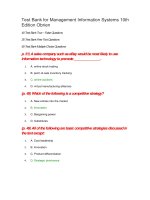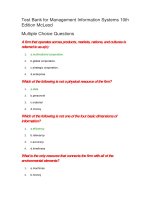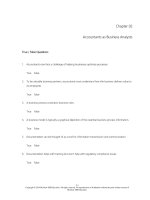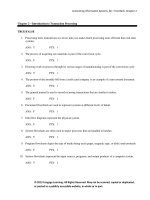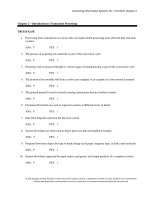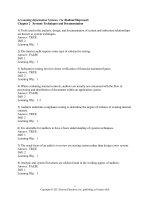Accounting information systems 10th edition gelinas test bank
Bạn đang xem bản rút gọn của tài liệu. Xem và tải ngay bản đầy đủ của tài liệu tại đây (261.82 KB, 20 trang )
Chapter 2—Enterprise Systems
TRUE/FALSE
1. One of the primary goals of implementing an ERP system is to standardize systems across multiple
locations and multiple divisions.
ANS: T
PTS: 1
2. Submitting a purchase order is a business event but creating an employee record is not a business
event.
ANS: F
PTS: 1
3. Early adopters of ERP systems were in the business of making products.
ANS: T
PTS: 1
4. ERP systems have proved to be quite easy to install and in short periods of time.
ANS: F
PTS: 1
5. Enterprise systems potentially integrate the business process functionality and information from all of
an organization's functional areas.
ANS: T
PTS: 1
6. With an enterprise system an organization will conduct business in a more costly manner.
ANS: F
PTS: 1
7. An add-on software module in an enterprise system might be a customer relationship management
system (CRM).
ANS: T
PTS: 1
8. The dominant player in the large system ERP arena is Microsoft.
ANS: F
PTS: 1
9. SAP has a primary focus on large Fortune 500 type companies.
ANS: T
PTS: 1
10. Microsoft Dynamics and Sage Group focus on small and mid market sized companies.
ANS: T
PTS: 1
11. Customer relationship management (CRM) software builds and maintains an organization's
customer-related database.
ANS: T
PTS: 1
12. Customer relationship management (CRM) software aggregates, manages, and retains data across the
entire organization for the identification, acquisition, and retention of vendors to maximize the benefits
of those relationships.
ANS: F
PTS: 1
13. If you have made a Web purchase such as with Amazon.com you have experienced some of the
functionality of a CRM system where the vendor keeps track of your name, address, and purchases.
ANS: T
PTS: 1
14. Customer relationship management (CRM) functionality includes procurement and contract
management.
ANS: F
PTS: 1
15. Customer self service (CSS) software is often an extension of CRM software.
ANS: T
PTS: 1
16. Supply chain management (SCM) software helps plan and execute steps such as demand planning,
acquiring inventory, manufacturing, distributing, and selling the product.
ANS: T
PTS: 1
17. Supplier relationship management (SRM) software manages the interactions with the organization's
that supply the goods and services to an enterprise.
ANS: T
PTS: 1
18. Middleware is a software product that connects two or more separate applications or software
modules.
ANS: T
PTS: 1
19. Enterpriseware might be used to stitch together a number of legacy systems, an enterprise system,
best-of-breed applications, and Web-based applications.
ANS: F
PTS: 1
20. An Application Programming Interface (API) is a means for connecting to a system or application
provided by the developer of that application.
ANS: T
PTS: 1
21. Microsoft Dynamics Snap line of tools is an example of an Application Programming Interface.
ANS: T
PTS: 1
22. Enterprise application integration (EAI) links together two or more systems and allows them to work
together.
ANS: T
PTS: 1
23. Product life-cycle management (PLM) software manages product data from design through
manufacture, and disposal.
ANS: T
PTS: 1
24. When choosing modules for an organization’s ERP system, it is generally best to select them all from
a single vendor.
ANS: F
PTS: 1
25. DreamWeaver is a Web services platform from SAP that can be used to build applications that
integrate business processes and databases from a number of sources within and between
organizations.
ANS: F
PTS: 1
26. Business process management (BPM) provides a comprehensive method for integrating manual and
automated internal processes, applications, and systems, as well as integration to external partners and
services.
ANS: T
PTS: 1
27. With a best-of-breed approach an organization can minimize the number of different software modules
employed to implement an enterprise system.
ANS: F
PTS: 1
28. Because of the enormous implementation costs, only very large organizations can afford ERP systems.
ANS: F
PTS: 1
29. The data captured as business events occur should be sufficient for someone who was not a party to
the event to understand and reconstruct what happened.
ANS: T
PTS: 1
30. The value chain is a chain of activities performed by the organization to transform outputs into inputs
valued by the customer.
ANS: T
PTS: 1
31. An organization creates a competitive advantage by creating less value for its customers than does its
competition.
ANS: F
PTS: 1
32. Supporting activities of the value chain include activities directly involved with marketing, producing,
selling, and delivering the product or service to the customer.
ANS: F
PTS: 1
33. Primary activities of the value chain provide infrastructure such as procurement, information
technology, human resources, and accounting.
ANS: F
PTS: 1
34. The value chain works to separate the functional activities or silos of the organization.
ANS: F
PTS: 1
35. Dell's value chain takes raw materials, manufactures computers and other products, and delivers them
to customers in a timely manner at an attractive price.
ANS: T
PTS: 1
36. The activities in the value chain, the value activities, are business processes that convert inputs to
valued outputs.
ANS: T
PTS: 1
37. In a disaggregated information system, the customer will be notified immediately whether the item is
on the shelf and not committed to another customer.
ANS: F
PTS: 1
38. Telling the customer when they will receive an item is known as available to promise (ATP).
ANS: T
PTS: 1
39. A character is a basic unit of data such as a letter, number, or special character.
ANS: T
PTS: 1
40. A field is a collection of related characters that comprise an attribute, such as a customer number or
name.
ANS: T
PTS: 1
41. A record is a collection of related data fields pertaining to a particular entity or event.
ANS: T
PTS: 1
42. The credit limit within a customer record always provides unlimited authorization to accept a customer
order.
ANS: F
PTS: 1
43. Segregation of duties includes separating the sales and credit departments.
ANS: T
PTS: 1
44. Generally, when processing a customer order, one does not need to know the total price of the goods
before credit authorization can be made.
ANS: F
PTS: 1
45. In an enterprise system, once a customer order is completed, the purchasing function can be
immediately informed that the merchandise has been sold and may need to be replenished.
ANS: T
PTS: 1
46. The Controlling module of the SAP system handles internal accounting and profitability analysis.
ANS: T
PTS: 1
47. An enterprise systems centralized database can make data, such as inventory data, visible throughout
the organization.
ANS: T
PTS: 1
48. The correct sequence of the three steps in the sales and distribution process are (1) order entry (2)
shipment process and (3) billing process.
ANS: T
PTS: 1
49. The correct sequence of the three steps in the materials management process is (1) record vendor
invoice (2) create purchase order (3) receive the goods.
ANS: F
PTS: 1
50. The bottom line is that without integrated information systems organizations have difficulty being
managed on a day-to-day basis and being successful in the long run.
ANS: T
PTS: 1
51. The financial accounting module integrates with the sales and distribution and materials management
modules.
ANS: T
PTS: 1
52. The purchase-to-pay process includes the events surrounding the sale of goods to a customer, the
recognition of revenue, and the collection of the customer payment.
ANS: F
PTS: 1
53. The order-to-cash process includes events surrounding the purchase of goods from a vendor, the
recognition of those costs, and the payment to the vendor.
ANS: F
PTS: 1
MULTIPLE CHOICE
1. Organizations install enterprise systems
a. to differentiate themselves from competitors
b. to reduce costs of conducting business
c. to improve performance
d. all of the above
ANS: D
PTS: 1
2. Core applications of an ERP are
a. financial accounting
b. materials management
c. sales and distribution
d. all of the above
ANS: D
PTS: 1
3. Which of the following is usually not part of an ERP's core applications?
a. legacy systems
b. financial accounting
c. material management
d. sales and distribution
ANS: A
PTS: 1
4. The enterprise system might facilitate the purchase of office equipment by all of the following except
a. providing an electronic order form (a purchase requisition)
b. assisting the vendor with the selection of the appropriate purchase order
c. routing the order to appropriate authorities for specific approval
d. making data available for management analysis
ANS: B
PTS: 1
5. The most dominant player in the ERP market for large companies is
a. Oracle
b. Sage
c. SAP
d. Microsoft
ANS: C
PTS: 1
6. Sales force automation software
a. automates order processing
b. monitors inventory
c. assists with employee performance evaluations
d. all of the above
ANS: D
PTS: 1
7. An application program interface (API)
a. is an approach that combines processes, software, standards and hardware to link two or
more systems together
b. is a means for connecting to a system or application provided by the application developer
c. streamlines the process between an enterprise and its customers
d. joins activities together into an end-to-end business process
ANS: B
PTS: 1
8. Software that builds and maintains an organization's customer-related database is known as
a. customer relationship management (CRM) software
b. customer self service (CSS) software
c. sales force automation (SFA) software
d. supply chain management (SCM) software
ANS: A
PTS: 1
9. Software that allows an organization's customers to complete inquiry without the aid of the
organization's employees is known as
a. customer relationship management (CRM) software
b. customer self service (CSS) software
c. sales force automation (SFA) software
d. supply chain management (SCM) software
ANS: B
PTS: 1
10. Software that automates sales tasks such as order processing and tracking is known as
a. customer relationship management (CRM) software
b. customer self service (CSS) software
c. sales force automation (SFA) software
d. supply chain management (SCM) software
ANS: C
PTS: 1
11. Software that helps execute steps such as demand planning, acquiring inventory, manufacturing,
distribution, and sales is known as
a. customer relationship management (CRM) software
b. customer self service (CSS) software
c. supplier relationship management (SRM) software
d. supply chain management (SCM) software
ANS: D
PTS: 1
12. Software that manages the interactions with the organization's that supply the goods and services to an
enterprise is known as
a. customer relationship management (CRM) software
b. customer self service (CSS) software
c. supplier relationship management (SRM) software
d. supply chain management (SCM) software
ANS: C
PTS: 1
13. Software that manages the product, beginning with the design of the product, continuing through
manufacture and culminating in the disposal of the product, is known as
a. product lifecycle management (PLM) software
b. product relationship management (PRM) software
c. product self service (PSS) software
d. supplier relationship management (SRM) software
ANS: A
PTS: 1
14. Supply chain management (SCM) software
a. is typically under the control of external partners in the chain.
b. helps plan and execute demand planning; acquiring inventory; and manufacturing,
distributing, and selling a product.
c. cannot be integrated into an overall ERP.
d. none of the above
ANS: B
PTS: 1
15. Some third-party modules can extract data from
a.
b.
c.
d.
legacy systems only
ERP systems only
both legacy systems and ERP systems
neither legacy systems nor ERP systems
ANS: C
PTS: 1
16. Which of the following tracks a product from design, continuing through manufacture, and
culminating with the disposal of the product at the end of its life?
a. supply chain management (SCM)
b. value chain
c. product life cycle management (PLM)
d. none of the above
ANS: C
PTS: 1
17. Technology that can connect together ERP systems and third party add-on modules is called
a. supply chain software
b. enterprise application integration (EAI)
c. EDP systems
d. none of the above
ANS: B
PTS: 1
18. Enterprise systems support an organization by:
a. facilitating the functioning of an organization's operations
b. retaining records about business events
c. storing data useful for decision making
d. all of the above
ANS: D
PTS: 1
19. The enterprise system might help purchase office equipment by
a. connecting directly to the enterprise system of the equipment vendor
b. verifying that appropriate approvals have been obtained
c. providing an electronic order form
d. all of the above
ANS: D
PTS: 1
20. A collection of entity/event instances is a
a. record
b. table
c. field
d. character
ANS: B
PTS: 1
21. Business events include
a. creating a new employee record
b. receiving a payment from a customer
c. submitting a purchase order to a vendor
d. all of the above
ANS: D
PTS: 1
22. The general term for software that connects third-party modules to ERP systems is known as
a. DreamWeaver
b. Middleware
c. Microsoft
d. NetWeaver
ANS: B
PTS: 1
23. Software packages that can be used for the core systems necessary to support enterprise systems.
a. Application Programming Interface (API) systems
b. Business Process Management (BPM) systems
c. Enterprise Resource Planning (ERP) systems
d. Event-driven architecture (EDA) systems
ANS: C
PTS: 1
24. This provides a comprehensive method for integrating manual and automated internal processes,
applications, and systems, as well as integration to external partners and services.
a. Application Programming Interface (API)
b. Business Process Management (BPM)
c. Enterprise Resource Planning (ERP)
d. Event-driven architecture (EDA)
ANS: B
PTS: 1
25. Primary activities of the value chain include
a. Accounting
b. Human Resources
c. Procurement
d. Production
ANS: D
PTS: 1
26. Supporting activities of the value chain include
a. Accounting
b. Marketing
c. Production
d. Sales
ANS: A
PTS: 1
27. Information technology (IT) has been able to create additional value by
a. reducing costs
b. improving quality
c. balancing the cost and timeliness of value activities
d. all of the above
ANS: D
PTS: 1
28. Which of the following statements is false?
a. Value chain activities need to be closely coordinated.
b. Primary value chain activities include marketing and sales.
c. An organization's value chain is the only component of the value system.
d. None of the statements are false.
ANS: C
PTS: 1
29. The correct sequence of elements leading to an "available to promise" (ATP) is
a. item availability, customer creditworthiness, price
b. customer creditworthiness, price, item availability
c. price, customer creditworthiness, item availability
d. item availability, price, customer creditworthiness
ANS: D
PTS: 1
30. The four Ws of capturing data do not include
a. Who
b. What
c. Why
d. When
ANS: C
PTS: 1
31. A basic unit of data such as a letter, number, or special character is known as a
a. Character
b. Field
c. Record
d. Table
ANS: A
PTS: 1
32. A collection of related characters that comprise an attribute such as a customer number or name is
known as a
a. Character
b. Field
c. Record
d. Table
ANS: B
PTS: 1
33. A collection of related data fields pertaining to a particular entity or event is known as a
a. Character
b. Field
c. Record
d. Table
ANS: C
PTS: 1
34. The correct sequence of events for entering a customer order is
a. edit order, record sales order, update inventory, notify warehouse
b. record sales order, edit order, update inventory, notify warehouse
c. notify warehouse, edit order, record sales order, update inventory
d. edit order, notify warehouse, record sales order, update inventory
ANS: A
PTS: 1
35. Steps in the sales and distribution process include all of the following except
a. order entry
b. shipment
c. receiving
d. billing
ANS: C
PTS: 1
36. Steps in the materials management process include all of the following except
a. creating the purchase order
b. shipment
c. receiving
d. recording the vendor invoice
ANS: B
PTS: 1
37. The ____ module plays a central role in the SAP system by collecting business events from other
modules.
a. human resources
b. controlling and profitability analysis
c. financial accounting
d. customer relationship management
ANS: C
PTS: 1
38. The ____ module of the SAP system handles internal accounting including cost center accounting,
activity-based accounting, and budgeting.
a. human resources
b. controlling and profitability analysis
c. financial accounting
d. customer relationship management
ANS: B
PTS: 1
39. The ____ module of the SAP system handles payroll processing.
a. human resources
b. controlling and profitability analysis
c. financial accounting
d. customer relationship management
ANS: A
PTS: 1
40. Which of the following is included in the first step in the order-to-cash process?
a. sales order processing
b. responding to customer inquiries
c. pick and pack
d. Billing
ANS: B
PTS: 1
41. What is the correct sequence of the order-to-cash process?
a. responding to customer inquiries; sales order processing; pick and pack; billing; shipping;
payment
b. sales order processing; responding to customer inquiries; pick and pack; shipping; billing;
payment
c. sales order processing; pick and pack; billing; shipping; payment; responding to customer
inquiries
d. responding to customer inquiries; sales order processing; pick and pack; shipping; billing;
payment
ANS: D
PTS: 1
42. What is the first step in the purchase-to-pay process?
a. purchase order processing
b. pick and pack
c. requirements determination
d. goods receipt
ANS: C
PTS: 1
43. What is the correct sequence of the purchase-to-pay process?
a. purchase order processing; goods receipt; invoice verification; payment processing;
requirements determination
b. requirements determination; purchase order processing; goods receipt; invoice
verification; payment processing
c. purchase order processing; requirements determination; goods receipt; invoice
verification; payment processing
d. requirements determination; purchase order processing; invoice verification; goods
receipt; payment processing
ANS: B
PTS: 1
COMPLETION
1. ______________________________ integrate the business process functionality and information
from all of an organization's functional areas, such as marketing and sales, cash receipts, purchasing,
cash disbursements, human resources, production and logistics, and business reporting (including
financial reporting).
ANS: Enterprise systems
PTS: 1
2. ______________________________ are software packages that can be used for the core systems
necessary to support enterprise systems.
ANS:
Enterprise resource planning (ERP) systems
ERP systems
Enterprise resource planning systems
PTS: 1
3. ______________________________ software builds and maintains an organization's customer-related
database.
ANS:
Customer relationship management (CRM)
CRM
Customer relationship management
PTS: 1
4. ______________________________ software allows an organization's customers to complete an
inquiry, perform a task (including sales), or troubleshoot problems, without the aid of an organization's
employees.
ANS:
Customer self-service (CSS)
CSS
Customer self-service
PTS: 1
5. ______________________________ software automates sales tasks such as order processing, contact
management, inventory monitoring, order tracking, and employee performance evaluation.
ANS:
Sales force automation (SFA)
SFA
Sales force automation
PTS: 1
6. ______________________________ software helps plan and execute the steps in an organization's
supply chain including demand planning; acquiring inventory; and manufacturing, distributing, and
selling the product.
ANS:
Supply chain management (SCM)
SCM
Supply chain management
PTS: 1
7. ______________________________ software manages the interactions with the organizations that
supply the goods and services to an enterprise.
ANS:
Supplier relationship management (SRM)
SRM
Supplier relationship management
PTS: 1
8. ______________________________ software manages product data during a product's life, beginning
with the design of the product, continuing through manufacture, and culminating in the disposal of the
product at the end of its life.
ANS:
Product life-cycle management (PLM)
PLM
Product life-cycle management
PTS: 1
9. ______________________________ is the dominant player in the ERP market for large businesses.
ANS: SAP
PTS: 1
10. ______________________________ includes integration of business processes, software, standards,
and hardware to link two or more systems together allowing them to act as one.
ANS:
Enterprise application integration (EAI)
EAI
Enterprise application integration
PTS: 1
11. The ______________________________ approach combines modules from various vendors to create
an information system that better meets an organization's needs than a standard ERP system.
ANS: best-of-breed
PTS: 1
12. A(n) ______________________________ is a means for connecting to a system or application
provided by the developer of that application.
ANS:
Application Programming Interface (API)
API
Application Programming Interface
PTS: 1
13. ______________________________ usually includes a design environment for modeling and
documenting business processes. This process is targeted at looking for improvements that can be
made to the existing system to increase efficiency and effectiveness.
ANS:
Business process management (BPM)
BPM
Business process management
PTS: 1
14. ______________________________ such as requiring separate authorizations for data-maintenance
and business event processing activities is important in the prevention of many fraudulent activities.
ANS: Segregation of duties
PTS: 1
15. The ______________________________ module plays a central role in the SAP system by
incorporating business events from other modules into the general ledger accounts.
ANS:
Financial Accounting
FI
PTS: 1
16. Primary activities of the ______________________________ include activities directly involved with
marketing, producing, selling, and delivering the product or service to the customer.
ANS: value chain
PTS: 1
17. The ______________________________ of the value chain include functions such as moving raw
materials into and around the organization, producing and delivering goods to the customer, and
performing services such as installation and after-sales support.
ANS: primary activities
PTS: 1
18. The ______________________________ of the value chain are those that provide infrastructure and
include functions such as procurement, information technology, human resources and accounting.
ANS: supporting activities
PTS: 1
19. Telling the customer when the item will be received is known as ______________________________.
ANS:
available to promise (ATP)
ATP
available to promise
PTS: 1
20. A(n) ______________________________ is a basic unit of data such as a letter, number, or special
character.
ANS: character
PTS: 1
21. A(n) ______________________________ is a collection of related characters that comprise an
attribute, such as a customer number or name.
ANS: field
PTS: 1
22. A(n) ______________________________ is a collection of related data fields pertaining to a
particular entity or event.
ANS: record
PTS: 1
23. The existence of the customer record, including the ______________________________, provides the
basic authorization required to accept and record the customer order.
ANS: credit limit
PTS: 1
24. The ______________________________ process includes the events surrounding the sale of goods to
a customer, the recognition of revenue, and the collection of the customer payment.
ANS: order-to-cash
PTS: 1
25. The ______________________________ process includes events surrounding the purchase of goods
from a vendor, the recognition of the cost of those goods, and the payment to the vendor
ANS: purchase-to-pay
PTS: 1
26. ______________________________ are older systems that may exist in an organization when a
newer system, such as an ERP, is installed.
ANS: Legacy systems
PTS: 1
27. SAP ________________ is a technology platform that allows a collection of applications to interact
and work together.
ANS: NetWeaver
PTS: 1
28. The four Ws of capturing data are ______________________________,
______________________________, ______________________________, and
______________________________.
ANS: who, what, where, when
PTS: 1
29. Edit order, record sales order, update inventory, notify warehouse is the sequence of events for
entering a(n) ______________________________.
ANS:
customer order
sales order
PTS: 1
30. The steps in the ______________________________ process include creating the purchase order,
receiving the goods and services, recording the vendor invoice
ANS:
materials management (MM)
MM
material management
purchase-to-pay
PTS: 1
31. The module that handles internal accounting including cost center accounting, activity based
accounting, and budgeting is ______________________________.
ANS:
controlling (CO) and profitability analysis (PA)
controlling (CO)
CO
CO/PA
controlling and profitability analysis
PTS: 1
32. The module that handles payroll processing is ______________________________.
ANS:
human resources (HR)
HR
human resources
PTS: 1
33. The first step in the order-to-cash process is ______________________________.
ANS:
presale activities
responding to customer inquiries
PTS: 1
34. The first step in the purchase-to-pay process is ______________________________.
ANS: requirements determination
PTS: 1
35. ______________________________ include any meaningful change in the state of an enterprise, such
as creating a new employee record, submitting a purchase order to a vendor, receiving a payment from
a customer, picking goods from a warehouse and delivering them to the shipping department, and
revaluing inventory.
ANS: Business events
PTS: 1
36. Third-party modules are connected to the ERP system using ______________________________, a
software product that connects two or more separate applications or software modules.
ANS: middleware
PTS: 1
ESSAY
1. Define enterprise resource planning (ERP) systems and give some examples of common ERP add-on
modules.
ANS:
Enterprise resource planning (ERP) systems are software packages that can be used for the core
systems necessary to support enterprise systems. ERP products are designed to offer integration of
virtually all of an organization's major business functions. Examples of common ERP add-on modules
include customer relationship management (CRM) software; customer self-service (CSS) software;
sales force automation (SFA) software; supply chain management (SCM) software; product lifecycle
management (PLM) software; and supplier relationship management (SRM) software.
PTS: 1
2. What are the primary activities of the value chain and what are some of the main functions included in
the value chain?
ANS:
The primary activities of the value chain include those directly involved with marketing, selling,
producing and delivering the product or service. This includes functions such as moving raw materials
into and around the organization, producing and delivering the products or services to the customer,
performing services such as installation and after sales support.
PTS: 1
3. List and describe the 6 steps in the order-to-cash process.
ANS:
1.
Pre-sales activities including responding to customer inquiries and RFQs.
2.
Sales order processing which includes capturing and recording customer orders.
3.
Pick and pack which includes picking the goods from the shelf in the warehouse and
packing the goods for shipment.
4.
Shipping the goods to the customer which includes selecting the appropriate carrier,
recording the reduction in inventory, recording cost of goods sold.
5.
Billing which includes preparing the customer invoice, recording sales, and recording
accounts receivable.
6.
Payment which includes recording cash receipts, updating cash and accounts receivable.
PTS: 1
4. List and describe the 5 steps in the purchase-to-pay process.
ANS:
1.
Requirements determination which includes preparing the purchase requisition.
2.
3.
4.
5.
Purchase order processing which includes preparing and recording purchase orders. In
an enterprise system where RFQs are used, it also includes analyzing vendor quotations.
Goods receipt which includes comparing the amount ordered to the amount received.
Invoice verification which includes receiving the invoice making a three way match of
the purchase order, the receipt, and the vendor invoice and recording accounts payable.
Payment processing which includes preparing and recording cash disbursements and
updating the cash and accounts payable accounts.
PTS: 1
5. Discuss three ways that enterprise systems achieve quality of information goals.
ANS:
The answer should include any three of the following.
Enterprise systems can collect a wide variety of data about business events and make that data
available for use to all interested and authorized persons inside and outside the organization. The data
should help all users (relevance, understandability) make decisions (decision usefulness) and analyze
past events to make predictions about future events (predictive/feedback value).
An enterprise system’s central database retains one version of data elements, uses that data to verify
the accuracy of new data elements entered into the database, and applies business rules to permit only
authorized changes to the database. Combined these improve the reliability, validity, and accuracy of
the database.
Organization-wide enforcement of data standards and business rules means that business events will be
handled consistently across the organization, that all relevant data will be collected (completeness) and
that the collected data will be verifiable and neutral.
The integrated nature of the enterprise system makes all data available in a timely manner.
The system facilitates the sharing of services for efficiency and consistency.
PTS: 1
6. List four pros and four cons of ERP packages.
ANS:
The pros should include any four of the following:
One package across many functions
Best practices
Modular structure
No development needed (unless modifications are required)
Configurable
Reduced errors (business rules, enter data once)
The cons should include any four of the following:
Complex and inflexible
Best practices are shared by all who use it
Difficult to configure
Long implementation
Best of breed might be better than single ERP package
Can’t meet all needs (developed for many user types)
PTS: 1
7. Why might a firm decide to implement only certain modules in an ERP system rather than a complete
implementation?
ANS:
The answer should include such items as:
Cost considerations
Implementing additional modules one at a time or on an as needed basis with additional modules
added at a later time
There may be legacy systems that they do not want to change
The firm may want to add on other modules from a combination of ERP vendors using enterprise
application integration
PTS: 1
8. What are the potential problems with a best-of-breed approach?
ANS:
Potential problems include sacrificing the tight integration offered by ERP systems, errors during the
translation and transmission between modules and higher total licensing, implementation and
maintenance costs than with a single provider.
PTS: 1
9. Describe and explain these concepts and their relationship to one another: enterprise application
integration, middleware, and application programming interface.
ANS:
Enterprise application integration (EAI) is an approach to connecting together multiple pieces of an
enterprise system and/or connecting the enterprise systems of different organizations. Middleware is a
software product that connects two or more separate applications or software modules in this approach.
An Application Programming Interface (API) is a type of middleware that is a means for connecting to
a system or application provided by the developer of that application.
PTS: 1
